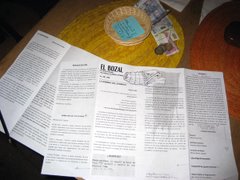

In the town of San Miguel de Allende, Guanajuato, there is a place dedicated to the conservation and appreciation of our natural resources. Set in the heart of the central highlands of Mexico, this reserve covers more than 100 hectares adjacent the historic town and is the result of non-governmental efforts, begun in 1990, to rescue and protect an area of outstanding natural beauty, of ecological and historical importance, open to all as a gathering place for the community.
El Charco del Ingenio is an extraordinary natural monument. Its name comes from a natural pool, nestled in an impressive canyon, which popular legend has interwoven with myths and stories since the Spanish conquest. Among the rocks and scrub lie vestiges of aqueducts and waterworks from the past. A historic reservoir receives the water draining from the nearby mountains, forming permanent wetlands where birds and other wildlife abound. During the rainy season, water overflows the dam, cascading into to pools in the wooded depths of the canyon. The high canyon walls open towards the west, with a magnificent view of San Miguel at the foot of the hills, the wide valley of the Laja River and on the far horizon, the Guanajuato Mountains.
This then is the setting for the Botanical Gardens, dedicated to the preservation of Mexican flora, with its surprising variety of families and species. It is a project with a novel approach, not bound by restrictive conventional models and looking beyond its own boundaries at endangered wildlife in order to encourage ordinary people to value and protect our natural heritage.
In addition to the restoration of native vegetation, El Charco del Ingenio maintains an extensive botanical collection of Mexican plants, many of which are rare or in danger of extinction. Consisting of mainly of cacti (of which Mexico boasts the greatest diversity in the world) and other succulents, these plants have been collected from many parts of the country, or propagated in the nursery here at the gardens. A large portion of this collection is housed, along with aquatic species and native fish, in the Conservatory of Mexican Plants, a greenhouse specially designed for their display.
Plants from this collection are on sale and provide a source of Mexican species for use in gardens and landscaping.
A network of paths takes the visitor from the information center located at the entrance to points of interest throughout the conservation area. These include the Plaza of the Four Winds, a community and ceremonial space with panoramic views; the impressive cliffs of the canyon; and the reservoir with its resident and migratory birds. These pathways, patrolled by our security staff, are ideal for walking, running, mountain bikes, and as access for rock climbing. The Nature Park, adjacent to the Botanical Gardens, provides a recreational area with vehicle access and facilities for camping, picnics, and horseback riding.
Managed by trained staff, the Botanical Gardens are a community resource for all ages and sectors of the population, with special emphasis on environmental education and its place in popular culture. A wide range of activities including community gatherings, courses, workshops, concerts and ceremonies take place here, reflecting the multicultural nature of San Miguel de Allende. Every year in July, the traditional festival of La Santa Cruz del Charco del Ingenio is held, bringing together a colorful mix of altars and local dances from communities throughout the region. Several times a month, the gardens host temascales, traditional herbal steam bath rituals, within the ruins of an ancient hacienda in the reserve.
El Charco del Ingenio is registered with the federal Mexican Environment Agency (SEMARNAT) as a conservation area with an intensive management plan. In addition, we carry out exchanges and programs with other Botanical Gardens and scientific institutions to share information about biodiversity and conservation. The land is managed by El Charco del Ingenio A.C.,a local, nonprofit organization whose purpose is to preserve this magnificent place and protect it for the future as part of San Miguel de Allende’s natural and historical heritage.
El Charco del Ingenio is an extraordinary natural monument. Its name comes from a natural pool, nestled in an impressive canyon, which popular legend has interwoven with myths and stories since the Spanish conquest. Among the rocks and scrub lie vestiges of aqueducts and waterworks from the past. A historic reservoir receives the water draining from the nearby mountains, forming permanent wetlands where birds and other wildlife abound. During the rainy season, water overflows the dam, cascading into to pools in the wooded depths of the canyon. The high canyon walls open towards the west, with a magnificent view of San Miguel at the foot of the hills, the wide valley of the Laja River and on the far horizon, the Guanajuato Mountains.
This then is the setting for the Botanical Gardens, dedicated to the preservation of Mexican flora, with its surprising variety of families and species. It is a project with a novel approach, not bound by restrictive conventional models and looking beyond its own boundaries at endangered wildlife in order to encourage ordinary people to value and protect our natural heritage.
In addition to the restoration of native vegetation, El Charco del Ingenio maintains an extensive botanical collection of Mexican plants, many of which are rare or in danger of extinction. Consisting of mainly of cacti (of which Mexico boasts the greatest diversity in the world) and other succulents, these plants have been collected from many parts of the country, or propagated in the nursery here at the gardens. A large portion of this collection is housed, along with aquatic species and native fish, in the Conservatory of Mexican Plants, a greenhouse specially designed for their display.
Plants from this collection are on sale and provide a source of Mexican species for use in gardens and landscaping.
A network of paths takes the visitor from the information center located at the entrance to points of interest throughout the conservation area. These include the Plaza of the Four Winds, a community and ceremonial space with panoramic views; the impressive cliffs of the canyon; and the reservoir with its resident and migratory birds. These pathways, patrolled by our security staff, are ideal for walking, running, mountain bikes, and as access for rock climbing. The Nature Park, adjacent to the Botanical Gardens, provides a recreational area with vehicle access and facilities for camping, picnics, and horseback riding.
Managed by trained staff, the Botanical Gardens are a community resource for all ages and sectors of the population, with special emphasis on environmental education and its place in popular culture. A wide range of activities including community gatherings, courses, workshops, concerts and ceremonies take place here, reflecting the multicultural nature of San Miguel de Allende. Every year in July, the traditional festival of La Santa Cruz del Charco del Ingenio is held, bringing together a colorful mix of altars and local dances from communities throughout the region. Several times a month, the gardens host temascales, traditional herbal steam bath rituals, within the ruins of an ancient hacienda in the reserve.
El Charco del Ingenio is registered with the federal Mexican Environment Agency (SEMARNAT) as a conservation area with an intensive management plan. In addition, we carry out exchanges and programs with other Botanical Gardens and scientific institutions to share information about biodiversity and conservation. The land is managed by El Charco del Ingenio A.C.,a local, nonprofit organization whose purpose is to preserve this magnificent place and protect it for the future as part of San Miguel de Allende’s natural and historical heritage.


